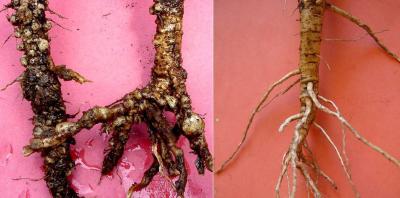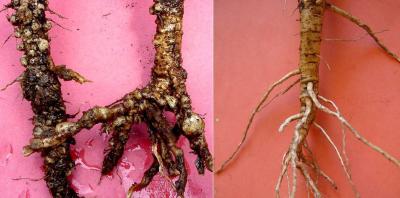

Root-knot nematodes (Meloidogyne spp.)
Potatoes are very susceptible to root-knot nematodes. Root-knot nematodes prefer warm temperatures and are likely to become established in potato crops grown in relatively warm areas. Generally, they are not a major problem in cool climate potato production areas, but can become a problem when potatoes are grown intensively or rotated with other susceptible crops. Infested potato plants may show varying degrees of stunting, yellowing of leaves and a tendency to wilt under moisture stress. Roots have swellings or galls. Affected tubers have blisters or swellings.
On potato tubers, galls may or may not be produced on the tuber surface, depending on cultivars. When galls are produced, they appear as small, raised lumps above giving the skin a rough appearance. Galls may be grouped in a single area or scattered near the tuber eyes. Infestations are difficult to detect in freshly harvested potato tubers.
Symptoms may develop when tubers are stored, particularly when taken to warmer climates where nematode numbers can rapidly increase. Symptoms are most severe when crops are grown on sandy soils and warm climates above 25 °C. Nematode attack reduces the quality, size and number of tubers.
Root-knot nematode infested potatoes can become more susceptible to bacterial wilt, and symptoms are more severe when plants are also infected with fungal pathogens such as Verticillium and Rhizoctonia.
Root-knot nematodes are mainly spread in potato tubers and in infested soil. Egg masses may be transported into clean fields via soil adhering to farm machinery. Spread within fields occurs during cultivation and in water, during irrigation or natural drainage.
- Practise proper crop rotation (e.g. potato - brassicas - cereals).
- Use mixed cropping or grow marigolds (Tagetes spp.) or sunn hemp (Crotalaria juncea).
- Maintain high levels of organic matter in the soil (manure and compost).
- Bio-fumigation (incorporating fresh plant mass, especially mustard or radish plants, in large amounts into the soil before planting potatoes) helps against root knot nematodes. Decomposing plant parts release compounds, which kill nematodes. Two weeks after incorporating plant material into the soil a new crop can be planted (phytotoxic effects are exhibited if the crop is planted before 2 weeks).
For more information on Biofumigation click here
